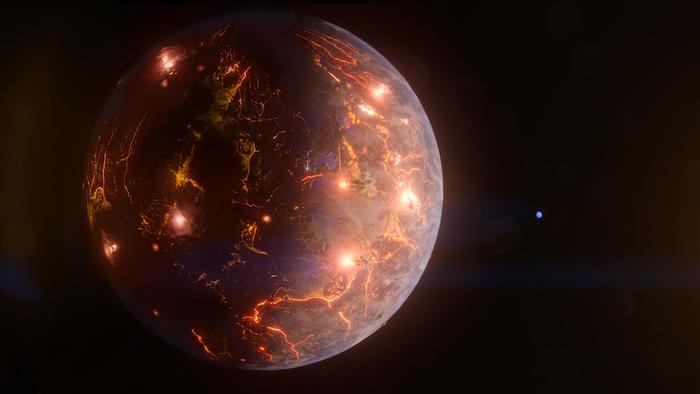‘Potentially volcano-covered’ Earth-size planet found orbiting star first described by KU astronomer

LAWRENCE — It’s Earth-sized, volcano-studded (possibly) and orbiting the cusp of a “habitable zone” around a star 90 light years away in a solar system first detailed by an astronomer at the University of Kansas. Meet LP 791-18 d, a fascinating exoplanet circling a small red dwarf in the southern constellation Crater, described for the first time today in the peer-reviewed journal Nature.
But don’t book your flight quite yet.
According to co-author Ian Crossfield, associate professor of physics & astronomy at KU, the discovery of the exoplanet mostly tells us more about the inner workings of a system initially detailed in a 2019 paper where he served as lead author (as well as other systems like it).
“In this system, named LP 791-18 along with the star, the star is cooler and smaller than the sun,” Crossfield said. “It's a system that was observed by NASA's TESS Space Telescope a number of years back now. With TESS, we were able to identify that there were two planets in the system — LP 791-18 b and c. The system was interesting for a couple of reasons, partly because this was one of the smallest, coolest stars found to have planets of any kind. Most of the planets we know about are around stars like the sun. Also, these are easier to study in some ways. From the few other planetary systems we know about, these small, cool, red dwarfs sometimes are likely to host lots of planets.”
The new paper detailing LP 791-18 d relied on data from NASA’s Transiting Exoplanet Survey Satellite (TESS) and retired Spitzer Space Telescope, as well as a suite of ground-based observatories, and was led by Merrin Peterson, a graduate student at the Trottier Institute for Research on Exoplanets (iREx) based at the University of Montreal.
The researchers believe the freshly discovered planet “could see volcanic flare-ups about as frequently as Jupiter’s moon Io, the most volcanically volatile body in our solar system.”
According to NASA, the presence of volcanos could suggest planetary habitability. But Crossfield resists the temptation to speculate whether such a planet could support life.
“The main discovery here is that we found a planet the size of Earth, much smaller than the planets b and c,” he said. “It'd be just a bit hotter than, say, the Earth is — or, at least it receives more starlight from its star than we do from the sun. We don't really know if it has an atmosphere, or if it has water, or if it has life, or if it could support life. We don't know any of that.”
While some data suggest the scientifically exciting possibility that LP 791-18 d is a volcanically active planet, Crossfield said the idea remains hypothetical.
“We don't know that there are any volcanoes here,” he said. “All we know is that this is a small planet that’s experiencing a straight-up periodic stretching due to its orbit around its star and near the other planets. That might cause lots of volcanoes like on Jupiter's moon Io, which is the most volcanically active thing in our solar system. We know about that because we've sent things nearby and taken pictures. There's not yet that kind of clear evidence yet with LP 791-18 d.”
Crossfield added the planet was scientifically fascinating regardless of its volcanism or potential to host life.
“People study Jupiter still, but they don't do it because they think there are aliens living there,” he said. “People study asteroids — just because we can and because we learn new things. Lots of exoplanet science is just about learning interesting things about the universe.”
Image: LP 791-18 d, illustrated here, is an Earth-sized world about 90 light-years away. The gravitational tug from a more massive planet in the system, shown as a blue disk in the background, may result in internal heating and volcanic eruptions – as much as Jupiter’s moon Io, the most geologically active body in the solar system. Astronomers discovered and studied the planet using data from NASA’s Spitzer Space Telescope and Transiting Exoplanet Survey Satellite along with many other observatories. Credit: NASA’s Goddard Space Flight Center/Chris Smith (KRBwyle)